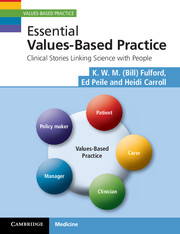Book contents
- Frontmatter
- Review quotes
- Contents
- Foreword
- Acknowledgements
- A bold claim to start this book
- Prologue: linking science with people
- Part 1 Values, individuals and an overview of values-based practice
- Part 2 The clinical skills for values-based practice
- Part 3 Relationships in values-based practice
- Part 4 Science and values-based practice
- Part 5 Bringing it all together
- 13 A good (enough) death: dissensus in end-of-life care
- 14 “It's my back, Doctor!” (episode 3): building a shared framework for values-based practice
- Postcript: the small change of care
- A bold claim to end this book
- Appendix A Values-based practice summary and definitions of key terms
- Appendix B Values-based practice teaching framework
- Index
13 - A good (enough) death: dissensus in end-of-life care
Published online by Cambridge University Press: 05 June 2012
- Frontmatter
- Review quotes
- Contents
- Foreword
- Acknowledgements
- A bold claim to start this book
- Prologue: linking science with people
- Part 1 Values, individuals and an overview of values-based practice
- Part 2 The clinical skills for values-based practice
- Part 3 Relationships in values-based practice
- Part 4 Science and values-based practice
- Part 5 Bringing it all together
- 13 A good (enough) death: dissensus in end-of-life care
- 14 “It's my back, Doctor!” (episode 3): building a shared framework for values-based practice
- Postcript: the small change of care
- A bold claim to end this book
- Appendix A Values-based practice summary and definitions of key terms
- Appendix B Values-based practice teaching framework
- Index
Summary
Topics covered in this chapter
A story from palliative care illustrates the role of dissensus (alongside consensus) in bringing together the elements of values-based practice to support partnership in decision-making.
Other topics include:
Multidisciplinary cancer care
The National Confidential Enquiry into Patient Outcomes and Death (NCEPOD)
Transition from (surgical) cure to (palliative) care
Spiritual and religious beliefs
Advance care planning (ACP) in end-of-life care
Consensus (in evidence-based practice) and dissensus (in values-based practice)
Reminders of process elements of values-based practice (VBP flashbacks).
Take-away message for practice
Dissensual decision-making can help usx to build genuine partnerships in working with other team members and with patients and their families.
Partnership between stakeholders in decision-making, although coming tenth in the list of process elements of values-based practice, is last but definitely not least in importance. We will see in this chapter that, as the tenth element, partnership draws together and underpins the process of values-based practice as a whole.
The importance of partnership in values-based decision-making is illustrated in this chapter through the story of a 69-year-old man, Joe Monaghan, after he is found to have disseminated bowel cancer following an emergency admission with acute abdominal symptoms. There has been much talk in such situations of a “good death.” But the surgical team and Joe Monaghan's various family members, as we will see, had very different perspectives on what a “good death” would mean, with Joe Monaghan himself, as is so often the case, at risk of becoming caught between their conflicting best intentions.
- Type
- Chapter
- Information
- Essential Values-Based PracticeClinical Stories Linking Science with People, pp. 165 - 182Publisher: Cambridge University PressPrint publication year: 2012



